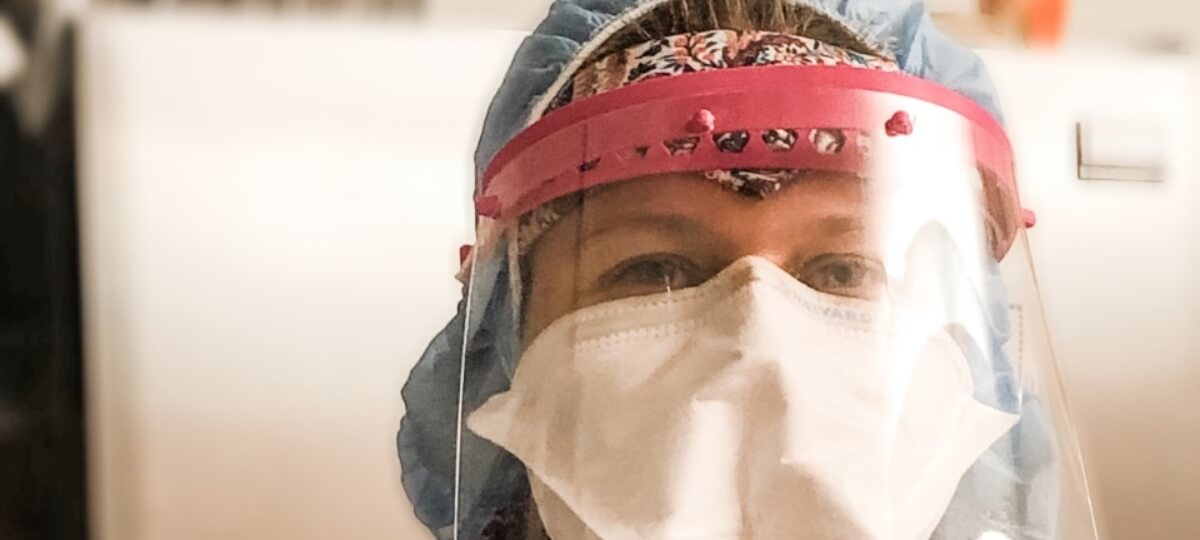

Courtesy of Samantha Phillips
Coronavirus
Courtesy of Samantha Phillips
Nurses On COVID-19 Frontline Risk It All
For an El Paso nurse, leaving her family to treat patients in New York City, the epicenter of the Coronavirus outbreak, isn’t a choice at all. It’s her calling.
This article was made possible because of the generous support of DAME members. We urgently need your help to keep publishing. Will you contribute just $5 a month to support our journalism?
Samantha Phillips was one of the first to join the nurses’ airlift into New York City. Since last month, thousands of RNs have been deployed to the city by emergency staffing organizations around the country. It is a military-style deployment. Although voluntary, large health crisis staffing agencies in the U.S. say their phones are red hot and burning with call-ins by nurses who want to be flown into the epicenter of the disease to back up the exhausted first responders pulling shifts of up to 20 hours.
From the moment Phillips first mentioned she might fly to New York, her husband, an army officer, supported her decision. Twenty-five years old, she was frightened as the only passenger on the empty plane leaving El Paso, Texas. After landing at LaGuardia with only a few bags and her heart racing, she was deployed to a beleaguered hospital in Coney Island.
“There was no orientation. No tour. Nothing,” she says. “The need was so dire that they threw us in and said, ‘Go help!’”
Her group of nurses was given PPE immediately upon arriving at their assigned hospital and learned they would have to reuse their hospital gear. They were told to go to their assigned units and begin work immediately. Phillips is an ER nurse who starts IVs, gives medications, and assists physicians in intubating patients when they go into respiratory failure. She also manages the ventilators while patients are in the ER.
“We had 126 patients in a 40-bed ER,” she recalls of the first night.
Patients were in hallways, some sitting in chairs once they ran out of beds. On her first few nights, the hospital was running out of oxygen in every form. That meant making tortuous decisions on who would get priority over others. Almost every patient was on some form of oxygen.
“I have worked at Level-1 trauma centers and have had mass casualties from shootings,” she says. “So I am not unfamiliar with death and having to move quickly.”
But instead of dealing with people being shot, these patients are being attacked by a virus. “It is nonstop running from one patient to the next, trying to keep them alive. We have three to five patients dying in an hour. We have to bag and tag them and move them to a back hallway and move the next living patient into their space.”
Phillips is honest in admitting, “We simply no longer have enough modern technology to care for everyone. So we’ve gone ‘old school.’” For example, the hospital ran out of medication pumps to correctly dose out the drugs. So Phillips says they have resorted to counting the drops per minute and doing the math to attempt to get the correct amount of medication into the patient.
This mass deployment of emergency nurses resembles the Berlin Airlift, the first battle of the Cold War. Western countries engaged in a massive airlift of food, water, and medicine to the citizens of Berlin because all other routes were blocked by the Soviet Union. Except that our current airlift is of people: RNs, traveling nurses, emergency room nurses, down to physician assistants.
Like Phillips, many of the nurses commit to 21 straight shifts of 12 hours each. Staffing agencies often send teams of mental health crisis response workers to provide much-needed support at the nurses’ hotels.
I asked Phillips if she questioned her decision to plunge into a dangerous environment. She described the passage she went through to adjust to her new reality. “I questioned myself up until my third shift at the hospital. I cried about risking my family, leaving a job I absolutely love, and forfeiting safety, all for strangers.”
After three days, the gravity of the situation hit her: “I may never come home. I could become sick and die in New York. I cried. But then, I reminded myself that while we are strangers, they need my help. I cried my first few shifts because everything was so hard. We were overflowing with patients and everyone was so sick. In fact, every single patient in that hospital was critically ill and on the verge of dying.”
But like so many nurses I have interviewed, their original commitment to this line of work was a profound, even spiritual, commitment to be helpful to others.
Phillips had her only child when she was 15. “At such a young age, it was difficult to understand what was happening, and even harder to seek medical help without finding judgment. I became very ill and was hospitalized for around a week during my seventh month of pregnancy. Everything was terrifying. The doctors would round in their groups and talk over me about my case, but no one ever stopped to explain what was actually happening.”
That’s when her nurses stepped in. “The nurses on my unit would come in after the physicians and tell me what they said in easy-to-understand terms. They explained the plan of care and treatment options. They comforted me and made me feel things would be okay. It was then I knew I wanted to be a nurse and be that lifeline for other people.”
After setting that goal as a freshman in high school, it was her family that came together to push her to go to college, while they watched her son so the aspiring nurse could attend classes, clinicals, and everything in between. Phillips had always been a “helper.” In high school, she assisted in creating a nonprofit, “Dots In Blue Water,” a water purification system her class created and took to Haiti. They installed the system to provide clean water, traveling to Haiti seven times.
Phillips’s son, now 10, stayed behind in Texas during her deployment.
“There are so many people dying,” Phillips says. “We notify family, make a note in the chart, and move on to the next living patients. You have to turn off the compassion part of you when patients die, or you won’t be able to move on to the next living one.”
Phillips is frank about the sense of helplessness nurses experience when their patients reach the point of “air hunger.” That’s the anxiety that occurs when your body is deprived of oxygen. “Patients then become so anxious and hard to calm, even though we give them medication to assist their breathing. There’s really not much we can do to make them feel better. It hurts so badly.”
The few original staff members that remain at the hospital keeps coming back, shift after shift, to fight this pandemic. “The virus came to them and took over their homes,” Phillips says. “They didn’t ask for this. I want to help them. And I want to help these patients, who are so sick and so scared. The devastating look on a patient’s face when they realize they most likely will not be going home is awful. I pray over my patients as I work. I know many people are also praying for me.”
In the early morning when she gets home from the night shift, Phillips Face Times with her husband, who is getting ready for work in El Paso.
I ask her what makes it hard to go to sleep. “Walking past so many rooms with body bags waiting to be transferred to the morgue,” she says. “You become numb. Some patients stick with you. You’ll be having a conversation with them, and within 20 minutes they can decompensate and die. It’s so hard. You’re thinking ‘Could I have done something differently?’ It’s just that the disease can progress that quickly.”
What gives her the strength to move on?
“I do a good therapeutic cry every morning when I get off shift and take my shower,” Phillips says.
Having friends helps, too. Even if they are temporary. The nurses in her group have bonded and lean on one another. They are mostly traveling nurses and are living in close quarters. “It’s like a bizarre summer camp,” she says with a laugh. “We try telling funny stories.”
Then, 2,000 miles from her family, alone in a closet-sized hotel room in the dead center of a grieving city, she tries her best to sleep as the rest of the world wakes up.
Before you go, we hope you’ll consider supporting DAME’s journalism.
Today, just tiny number of corporations and billionaire owners are in control the news we watch and read. That influence shapes our culture and our understanding of the world. But at DAME, we serve as a counterbalance by doing things differently. We’re reader funded, which means our only agenda is to serve our readers. No both sides, no false equivalencies, no billionaire interests. Just our mission to publish the information and reporting that help you navigate the most complex issues we face.
But to keep publishing, stay independent and paywall free for all, we urgently need more support. During our Spring Membership drive, we hope you’ll join the community helping to build a more equitable media landscape with a monthly membership of just $5.00 per month or one-time gift in any amount.




















































































